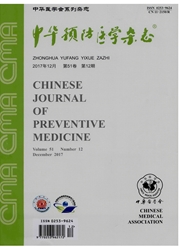

 中文摘要:
中文摘要:
目的了解高水碘地区儿童的甲状腺功能及甲状腺疾病患病情况。方法于2010年4月采用立意抽样的方法抽取河北省沧州市海兴县两所小学,再采用整群抽样抽取6个班级儿童共371名,采集每个儿童的静脉血5ml、晨尿5ml,测定儿童尿碘、血清游离三碘甲状腺原氨酸(free triiodothyronine,FT3)、游离四碘甲状腺原氨酸(free thyroxine,FT4)及灵敏促甲状腺激素(sensitive thyroid—stimulating hormone,sTSH)水平,用于评估儿童碘营养状况、甲状腺功能及甲状腺疾病患病情况。结果调查对象尿碘中位数为1032.8ug/L,其中尿碘水平≥300ug/L者占96.2%(357/371),处于碘过量状态;而尿碘≥800ug/L者占68.5%(254/371)。血清中FT3、FT4分别为(6.28±0.81)pmol/L、(16.37±2.72)pmol/L,sTSH中位数为4.01mU/L;男童水平FT4[(16.63±2.60)pmol/L]高于女童[(15.99±2.85)pmol/L](P〈0.05)。检出甲状腺疾病患者44例(11.9%),其中亚临床甲状腺功能减退者25例(57%),甲状腺功能减退者4例(9%),甲状腺功能亢进者10例(23%),亚临床甲状腺功能亢进者5例(11%)。尿碘在200~799ug/L时,儿童甲状腺疾病和亚临床甲状腺功能减退的患病率为6.3%(7/111)和14.6%(27/254),尿碘≥800ug/L时,儿童甲状腺疾病和亚临床甲状腺功能减退的患病率分别为3.6%(4/111)和8.3%(21/254)。结论高水碘地区大部分儿童碘摄入过量,儿童甲状腺激素水平均在正常值范围,甲状腺疾病的患病率较高,以亚临床甲状腺功能减退为主。
 英文摘要:
英文摘要:
Objective To understand the level of thyroid function and the prevalence of the thyroid diseases of children in high water iodine areas. Method Two primary schools were selected by purposive sampling from Haixing county, Hebei province in April 2010. A total of 371 children were selected from six classes by cluster sampling in the schools. Morning-urine and venous blood(5 ml) were collected to measure the levels of urinary iodine, free triiodothyronine ( FT3 ), free thyroxine ( FT4 ) and sensitive thyroid- stimulating hormone (sTSH) in serum and to evaluate the iodine status and thyroid function of children. Results The median urinary iodine of the children was 1032.08 ug/L. Overall, 96. 2% (357/371) of the children's urinary iodine were ≥300 ug,/L and 68.5% (254/371) were ≥800 ug/L. The level of FTs and FT4 were ( 6. 28 ± 0. 81 ) pmol/L and ( 16. 37 ± 2. 72 ) pmol/L, respectively. The median of sTSH was 4. 01 mU/L. The FT4 among boys (( 16.63 ± 2.60 )pmol/L) was significantly higher than that among girls( ( 15.99 ± 2. 85 ) pmol/L) (P 〈 0.05 ). Overall ,44 subjects were diagnosed as thyroid disease (11.9%) ,25 were subclinical hypothyroidism(57% of the total patients) ,4 were hypothyroidism (9%), 10 were hyperthyroidism(23% ) and 5 were subclinical hyperthyroidism (11% ). In the urinary iodine of 200 -799 ug/L, the prevalence of thyroid disease and hypothyroidism were 6. 3% (7/111 )and 14. 6% (27/254), respectively. When urinary iodine ≥ 800 ug/L, the prevalence of thyroid diseases and hypothyroidism were 3.6% (4/111 ) and 8.3% (21/254) , respectively. Conclusion Most of the children in high water iodine areas had excessive iodine intake. Levels of the children's thyroid hormone were within the normal range. The prevalence of thyroid disease were high, in these areas and the thyroid disease were mainly the subclinical hypothyroidism.
 同期刊论文项目
同期刊论文项目
 同项目期刊论文
同项目期刊论文
 Exploration of the safe upper level of iodine intake in euthyroid Chinese adults: a randomized doubl
Exploration of the safe upper level of iodine intake in euthyroid Chinese adults: a randomized doubl 期刊信息
期刊信息
